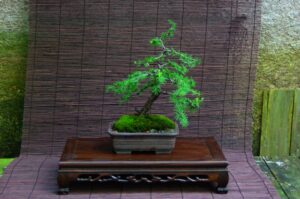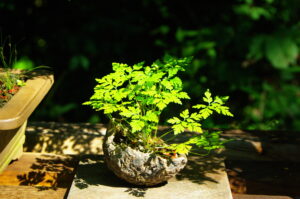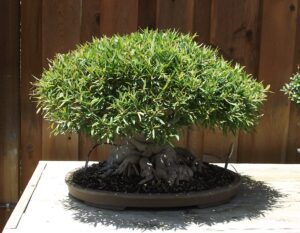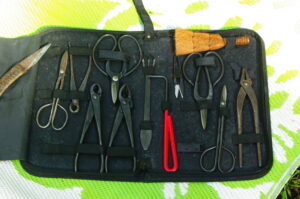Bonsai tools for beginners — Developing your bonsai tool box
Consider a carpenter with their hammer, nails and saw or an artist with their brush, paints and easel how successful would they be without these simple core tools?
Similarly, no matter whether you are new to the art of bonsai or an experienced professional there is a base group of tools that are essential to your success. It would be convenient to just create a list of bonsai tools for beginners and call it a day. However, this does not set up those new to the bonsai experience for success. Additionally, there can be overlap in what is considered a “Tool” vs. “Supplies” and can cause some less experienced individuals, to overlook essential ingredients to succeed in their bonsai experience.
What do I really need to start off?
How much should I pay for it?
Can I substitute?
Maintenance?
Our goal here is to provide, beginning level students a general understanding of the core tools and their use as it applies to bonsai culture. This sets the beginning student up for success and continued participation in the bonsai community.
Bonsai – Size, It has an impact.
Without getting into the details of size classification, it is enough to note there are classifications and in general they relate to the size of the tree as measured from the soil surface to the apex. Naming convention can also relate to the style of tree, but size is what we’re worried about when selecting bonsai tools for beginners.
Tree Class --- Tree size Kenshitsubo --- 1- 3 Inches Shito --- 2 - 4 Inches Mame --- 4 – 8 Inches Shohin --- 6 – 8 Inches Komono --- 6 – 10 Inches Kifu Sho Up to 16 Inches Katade mochi --- 10 --- 18 Inches Chumono, Chiu – 16 --- 36 Inches
The top 9 tools – You can’t live without.
There is a wide variety of opinion as to what the beginners tool box should consist of. A simple search on the net will provide sites selling all manner of tools. None of the sites tell you why you need them but the implication is “you do”. The connection to the size of the material you are working on is obvious but often over looked in the heat of the purchase.
Since it has been our experience most start off in the Small to medium range we will discuss what will work for trees of that size. The student can adjust according to the size tree you are working with.
The following is our recommended list, which we will be discussed in further detail in the next section on tool use. This tool set will work with most of the sizes listed but you may need some larger tools especially with trees above 16 inches tall
- Concave cutters, 7-inch size (no substitute)
- Knob Cutters, 7-inch size ( AKA melon baller’s-No substitute)
- Root Hook, 7- Inch single hook (Purchase or DYI, No substitute)
- Trimming Scissors/shears, several sizes (Substitutes)
- Small pocket Knife or Grafting knife (No substitute)
- Wire snips (Substitutes)
- Jinn Pliers, (Substitutes)
- Various diameters of Bonsai wire 1.0 through 4.0 (Copper or Aluminum, No substitute).
- Cutting Paste.
Additional tools for Re potting
- Potting Soil, (Depends on tree)
- Screen for drainage holes (substitutes)
- Root hormone (No substitutes)
- Mycorrhiza- Mix (endo/ecto General Mix)
Tool uses – Tools for every job
Concave cutters
Concave cutters are the quintessential bonsai trimming tool. Mostly used for light branch cutting it can be used for root cutting and most general trimming needs. The cuts are surface to above surface cuts. This is a special tool and though there are garden implements that cut they are no substitute for a good set of concave cutters.
Knob Cutters
Knob cutters are similar in purpose to concave cutters but are designed to make sub surface cuts. They have a rounded cutting face and will make a small divot in the branch or trunk if used correctly. This is so the cut will heal flush to the surface and avoid creating an unsightly bulge when the callous forms. This is a special tool designed for a specific purpose there is no substitute
Root Hook
A good root hook is essential for the re-potting process and is designed to cleanly remove soil from roots without significant damage. There are many designs but the one I recommended is a single re-curved hook made from 3/8” to 1/25” diameter wire. To save costs one could fashion a reasonable hook from the appropriate hardware store rod stock with little effort.
Trimming scissors/shears
Trimming scissors/shears are as described, this tool is for light cutting on small twigs, leaf and bud pruning. There are many sizes and substitutions available. Shears and concave cutters are the most used tools in the tool box.
Small pocket knife/Grafting knife
This is your general cutting tool and is used for cleaning around Jin and dead wood, carving, Grafting. A good quality 3 inch pen knife with sharp edge works fine for this.
Wire snips
A good set of wire snips are essential to the training process for cutting and removing the wire used to direct branch position. A medium long handled set from a hardware store will work fine.
Jinn Pliers
Jinn Pliers are a narrow long handled set of pliers that aid in removing bark to create jinn or to aid in fine wiring. There are some possible hardware store substitutes but make sure to use rounded nose varieties.
Bonsai wire
Bonsai wire is essential for the training process and is used to position the tree branches. I highly recommended a good selection of gauges from 1.0 through 4.0. You have the options of copper or aluminum though I prefer aluminum. There are pro’s and con’s for each variety for example with copper smaller diameters have greater holding power compared to aluminum, conversely aluminum is less expensive and less likely to damage soft barked species like azalea.
Cutting Paste
This is used to seal and protect large cuts due to branch removal broken branches and other injuries.
You can purchase cutting paste from well-equipped nurseries at elevated costs however a good substitute is plumbers putty especially if it contains shark oil. I have used plumbers putty for years on a variety of trees without issue.
Tool costs- what can I afford ?
Tool costs can vary greatly depending on source, metals used, like stainless steel or carbon steel?
name brand or generic. The key aspects of any tool is wear-ability ( how long will it last), does it hold an edge and does it do what it was designed for (utility). I recommend getting an inexpensive set of Chinese or Indian carbon steel tools for the beginning student. I do this mainly due to cost and availability. Once the student learns proper use and maintenance of these tools they can graduate to a professional level set at significantly greater cost. On the entry level target a cost of $20 or less per tool this is where buying an entry level set may be adventitious.
The bonsai Journey
 |  |  |
There is a core tool list that all beginning level students should obtain. These are the bare minimum to be able to effectively work with bonsai and achieve some level of success. Remember to take tree size into consideration – larger trees generally require larger tools. Tool costs can be intimidating especially with beginning students. A cost of about $20.00 per tool is a reasonable expectation also consider buying a complete set to take advantage of discount pricing.
Most of all enjoy your bonsai journey this is a great community and I am sure you will be a welcomed addition!
Please feel free to ask questions or leave comments and we will do our best to get back to you.
Sincerely,
John Rough,
John@blackdodgebonsai.com

POST YOUR COMMENTS